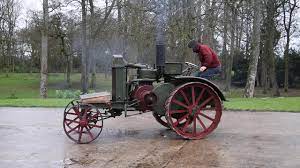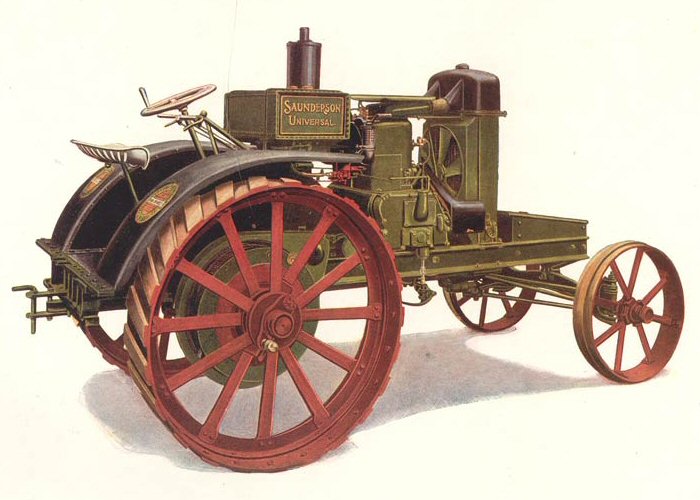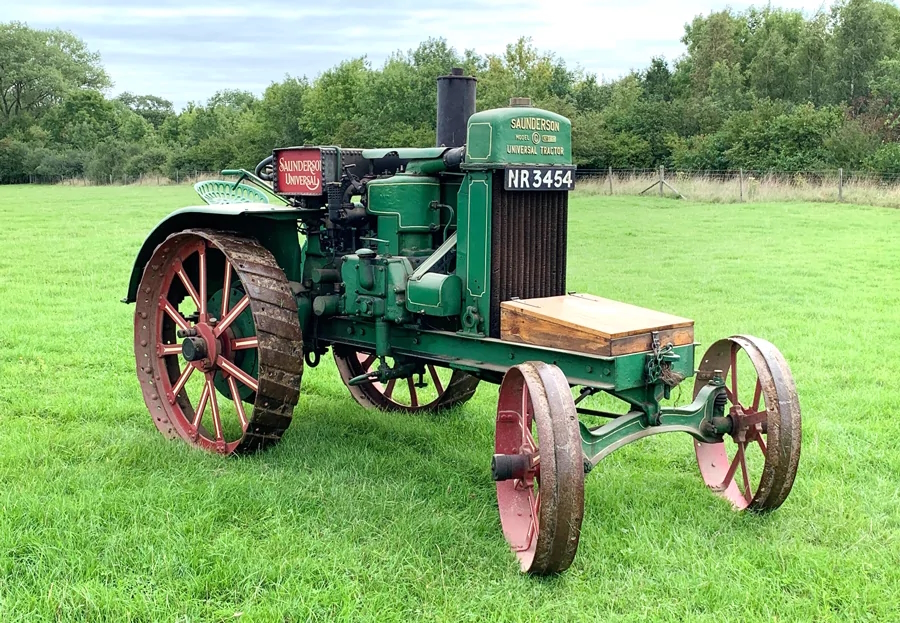Saunderson
H.P. Saunderson & Co. / Saunderson & Gifkins / Saunderson & Mills / Saunderson Tractor & Implement Co., Elstow Works, Bedford, England
Crossley Motors, Manchester, England
History

Saunderson Model G tractor from 1919 catalogue
(click on image to enlarge)
Herbert Percy Saunderson was born in 1869 in
Bedfordshire, England, where he trained as a blacksmith. After time
spent in Canada as a farmer and fur-trapper, he returned home to
Bedfordshire and established himself as an agent for the Canadian
Massey-Harris company, operating from a small workshop behind his
house in Kempston. Saunderson also began to build a range of his own
equipment including windmills, pumps and weed clearing machinery,
and in the late 1890s he developed a self-propelled vehicle. This
was a light goods truck powered by a single-cylinder 6.5 x 10in
engine that could run on either gas or petrol, with chain drive to
the rear wheels and two forward speeds. Saunderson entered it in a
trial of self-moving vehicles organized by the Royal Agricultural
Society in 1898, but unfortunately it experienced engine problems
and failed to complete the course. In 1900, Saunderson opened the
Elstow Works in Bedford and began to turn his attention to tractors.
The first Saunderson tractor appeared in 1904 -
this was a two-wheeled machine that was intended to be coupled to
various horse-drawn implements. This was followed a few years later
by the first Saunderson "Universal Motor", a 45-50 hp tractor with
three equal-sized wheels and all-wheel drive. In 1907, one such
tractor was awarded a gold medal at the Italian Government trials at
Piacenza, Italy. A 1908 catalogue listed three different models of
"Universal Motor", including two different four-wheeled machines
that were equally at home on the road and in the field, thanks to a
removable lorry body. Saunderson was also moving into the export
market, with "Universal Motors" being shipped as far afield as
Canada, Australia and New Zealand.
By 1910 the company name had changed to Saunderson
& Gifkins, with a new partner providing much-needed financial
support. Although the earlier designs were still being offered,
several new tractors were also introduced, ranging from the little
Model L with a single-cylinder air-cooled engine and removable
transport body to the huge Model V with a four-cylinder power unit
developing around 50 hp. In 1912 a new partner, Mr J. Gawler Mills,
was found and the company name was again changed to Saunderson &
Mills. It was around this time that the Model G tractor appeared,
which was to prove Saunderson's most successful and long-lived model
- one of these took first place in the agricultural trials at Port
Elizabeth, South Africa in 1913. By the First World War, Saunderson
had become the largest tractor manufacturer outside the United
States, and Saunderson tractors were being used on every continent.

Batch of Model G tractors for the British Board of Agriculture
(click on image to enlarge)
The
final and most significant change to the tractor range came in 1916,
when the design was completely overhauled - the most obvious changes
were the repositioning of the driver's seat to the rear of the
tractor, allowing a better view of trailed implements, and the
radiator to the front. The same year, King George V chose to
purchase a Model G tractor, plough and fuel/water wagon for use on
his Sandringham estate in Norfolk, which provided excellent
publicity for Saunderson. The company's tractors were also used on
the Prince of Wales's estate in Cornwall. In 1917 an order for 400
Model G tractors and ploughs was placed by the British Board of
Agriculture, providing a massive boost for Saunderson. Around this
time Mr Mills left the firm, and the name changed once again to the
Saunderson Tractor & Implement Co.
Nevertheless, the emergence of the Fordson tractor
and problems with the export market following the First World War
caused problems for Saunderson, and the Model G began to look rather
dated. A 1919 brochure shows a slimmed-down range of just three
models that were almost identical in appearance. An agreement was
reached for the post-war range of tractors to be built in France
under the SCEMIA name. A 12-20hp "Super Light-Weight" tractor
with V-twin engine was also introduced in 1923, but met with little
success, while another small tractor design with a more conventional
engine, the Saunderson "Junior", does not seem to have progressed
beyond the prototype stage. The following year, Herbert Saunderson
took the decision to sell the tractor business to Crossley Motors of
Manchester, who had already been supplying the engines for
Saunderson tractors for a number of years. Saunderson stayed on in a
consultancy role for a year, before retiring to an estate in
Bedfordshire with several of his tractors. Crossleys continued to
market the Model G for a few more years with their own name on the
radiator, but with little commercial success.
<Model Details
Type A

H.P. Saunderson & Co. Type A (click on image to enlarge)
The
Type A was a three-wheeled machine with equal-sized wheels and
all-wheel drive. It was powered by a four-cylinder engine of
Saunderson's own design with a bore and stroke of 6in x 6in running
at 600-800rpm and producing 45-50bhp. Ignition was via trembler
coil, but a magneto could be provided at extra cost. The tractor had
three speeds both forward and reverse of approx. 2.5, 3.5 and 7 mph.
The drive gears were protected by pressed steel and the spring were
provided for driver comfort. A tubular radiator with fan in front
belt driven from the forward-mounted pulley was used for cooling.
The tractor had a passenger seat on the opposite side to the driver
and a load-carrying platform at the rear which could be removed as
required. The Type A later became known as the Model U with minor
modifications.
Type B
The Type B was similar in
appearance to the Type A, but with four wheels rather than three and
a slightly smaller engine of 5 x 6 in bore and stroke developing
30-35bhp. Only the rear wheels were driven while the front wheels
steered. A larger load-carrying platform was provided at the rear
than on the Type A, and the wheels could also be supplied with
smooth tyres for road-haulage use. Standard wheels with removable
bolt-on strakes were provided for general-purpose use.
Type C
This was a narrow-gauge version of
the Type B with a track width of 4 feet, intended for working in
sugar cane and other plantations.
Model L
A new model for the June 1910
Saunderson & Gifkins catalogue was the "Little Universal Motor"
Model L, a 6-7bhp machine weighing just over a ton and powered by a
single-cylinder air-cooled engine with 5.25 x 6in bore and stroke. A
special hinged single-furrow plough was advertised as well as a
matched threshing machine to be driven from the tractor's belt
pulley. As with earlier models, a removable lorry body allowed the
Model L to be used equally well for road transport purposes. The
seating position was now right at the front of the tractor, with all
the controls within easy reach.
Model F
Also described as a "Little
Universal Motor", the 12-14bhp Model F was the big brother to the
Model L and very similar in appearance. This time though a
two-cylinder water-cooled engine was fitted with a large radiator at
the rear of the tractor. Initially the seating position on the Model
F was located at the front of the tractor, but this was later moved
to the right-hand side.
Model K
The Model K was completely
different in appearance from the previous two. Described as a
25-30bhp machine, it used a four-cylinder 5 x 6in engine that was
centrally mounted, with the driver's position to the right of this
and a honeycomb radiator in front. It also had Saunderson's advanced
three-point suspension, which allowed it to pass over the roughest
of terrain, and a differential lock for the rear wheels.
Model V

Saunderson & Gifkins Model V (click on image to enlarge)
The
Model V was Saunderson's flagship model and had a rating of
45-50bhp. It used a four-cylinder 6 x 8 in engine. The Model V seems
to have been one of the most popular export models, as photos show
them being worked in such diverse places as Russia, West Africa and
New Zealand, and it was also marketed by several companies in
central and eastern Europe.
Model C
An updated version of the Type C
listed in the 1910 catalogue, and offered with a special plough and
hinged rear-mounted cultivator.
Model D
Updated version of the Type B
fitted with the same honeycomb radiator as the Model K and V.
Model U
Slightly modified form of the
earlier Type A.
Model G
The first version of the most
successful and long-lived Saunderson tractor, the 20bhp Model G,
appeared around 1911 as part of the Saunderson & Gifkins range.
The first version was almost identical to the improved Model F, and
used a two-cylinder T-head engine mounted crossways on the chassis
in the middle of the tractor. The driver sat slightly forward and to
the right of this, which gave good visibility to front and rear,
allowing him to see past the large radiator and fuel tank assembly
positioned above the back wheels. A sizeable toolbox was provided at
the front of the tractor, a feature that was to become a signature
of Saunderson tractors, and a full length canopy was also an option.
This design was carried over to the Saunderson & Mills range,
but by 1915 a few changes had taken place - the operator's seat and
controls had been moved to the front of the engine, drive gears were
now fully enclosed to protect them from dirt, and the toolbox was
now vertical rather than flat. Very soon afterwards though, the
Model G received its final and most drastic overhaul, which is
described separately below.
Model S
Updated version of the Model V
with a number of improvements such as repositioning the radiator at
the rear of the tractor.
Model B
Updated version of the Model K
with minor modifications.
Model J
This was almost identical to the
forward-control Model G, but with half the rated power. It was
described in the 1915 Saunderson & Mills catalogue as a little
"knock about" of the farm that was suitable for pairing with a
two-furrow plough, 6ft binder or cultivator, or two mowers. On the
road, it could pull a load of 2-3 tons.
The
final configuration of the Model G emerged in 1916 and featured what
was to become the conventional layout for a tractor: radiator at the
front, engine and gearbox in the middle, and driver's seat at the
Initially listed under the Saunderson & Mills name, it was a
23hp machine with a two-cylinder L-head engine with 5.5 x 8 in bore
and stroke and that normally ran at 750rpm. Three forward speeds and
one reverse were provided and gears were selected using a pair of
handlebar-like levers on either side of the steering wheel. Power
was transmitted via a friction-type clutch and enclosed final-drive
gears. Inside one of the rear wheels was a differential that could
be locked with a pin and a winding drum and cable for hauling. The
front axle and driver's seat were sprung and the tractor had
Saunderson's patent three-point suspension. Cooling was via a
tubular radiator, fan and thermosyphon method.
With the renaming
of the firm as the Saunderson Tractor & Implement Co. towards
the end of the First World War, the only change seems to have been
the replacement of the small brass or aluminium maker's plate on the
radiator with a larger cast iron one. The appearance of the
"Improved Post-War Model G" in 1919, however, saw the header tank
modified again to include the company name in large cast lettering
and other changes to the manifold, fuel tank and engine. The
following year the radiator was changed yet again, this time to a
lower honeycomb design with the "Saunderson" name painted on. The
engines for the tractors were now built by Crossley Motors rather
than the National Gas Engine Co. The magneto was also changed from a
Thomson-Bennett to a Hills Bros. type. With the takeover by Crossley
Motors in 1924, the Saunderson name on the radiator and fuel tank
sides was replaced by the Crossley one.
Model J (rear-steer)
This was similar in
appearance to the Model G, but was rated at 10-12hp and used a
single-cylinder engine. The tractor was also narrower and had
smaller wheels.
Model B (rear-steer)
A slightly larger
version of the Model G, this time rated at 30-32hp. The most obvious
external differences were the lower radiator (as on the Model G
after 1920) and larger fuel tank.
Type T "Super Light-Weight"
With its
fully-enclosed 20hp V-twin engine, height of 4ft 4in and 42in rear
wheels, the Super Light-Weight tractor was a radical departure from
previous models. It also featured Saunderson's patented design of
combined engine and gearbox using roller bearings, and was fitted
with a water pump and impulse magneto. With 12hp available at the
drawbar and two forward speeds, it was advertised as capable of
pulling a two-furrow plough in any soils and a three-furrow one
under suitable conditions.




